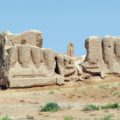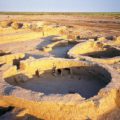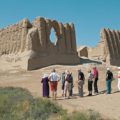Margiana is an ancient kingdom that existed in the territory of today’s Turkmenistan in 5–3rd centuries BC. Margiana was first mentioned in writing in Avesta, the sacred book of Zoroastrianism, under the name of Mouru, while the Persians called it Margush.
During the eastern campaign of Alexander the Great, Greek historians began to call this country Margiana for easier pronunciation, and this is the name that the world’s historical science uses today. Researchers believe that all these different names are in fact derivatives from the common root ‘Murgh’, the same one that the name of the river Murghab came from. Margiana kingdom was located in its basin, while its core territory was the ancient Merv, the oasis whose history dates back to the first human settlements on the banks of the Murghab River.
An important mention of Margiana was found in the trilingual cuneiform text of the Behistun inscription, engraved by order of King Darius I to describe the events that took place in 523–521 BC on a rock next to the Great Road of Khorasan, connecting Babylon and Ecbatana. That rock is around 30 kilometers from the Iranian town of Kermanshah.
In the mid-6th century BC, Margiana was conquered by the Persians. Shortly after, as Darius I was strengthening his power, a massive popular revolt against the Persian rule broke out, according to the Behistun inscription:
“King Darius says: The province called Margiana revolted against me. A certain Margian named Frâda they made their leader. Then sent I against him a Persian named Dâdarši, my servant, who was satrap of Bactria, and I said unto him: ‘Go, smite that host which does not acknowledge me.’ Then Dâdarši went forth with the army, and gave battle to the Margians. Ahuramazda brought me help; by the grace of Ahuramazda my army utterly overthrew that rebel host. Of the twenty-third day of the month Âçiyâdiya was the battle fought by them. Then was the province mine. This is what was done by me in Bactria”.
The exact location of Margush remained a mystery for a long time, and only in the mid-20th century member of the academy Vasily Struve used ancient texts to prove that the country Margush, aka Margiana, was located in the former basin of the Murgab River delta in the south-east of Turkmenistan.
Large-scale archaeological explorations and excavations began in early 1970s by the Margush archaeological expedition under the leadership and with active involvement of Viktor Sarianidi. The expedition was organized by the Institute of Archaeology of the USSR Academy of Sciences and was joined by Turkmen researchers. After many years of excavations, the scholars concluded that the ancient country of Margush not only had many similarities with the ancient East, but, given its numerous unique features, was the fifth centre of the global civilization along with Mesopotamia, Egypt, China and India.
In 1972, during excavations on a low hill on the right bank of the Murghab River, Sarianidi’s archaeological expedition discovered an entire archaeological park in a desert area and the ruins of a magnificent Bronze Age settlement (2300 BC). The archaeologists found out that it was Gonur Depe, the capital of the ancient country of Margush mentioned in the Behistun inscription. Gonur Depe was the largest settlement in Margiana and a regional centre of Zoroastrianism, with its own palace and several temples of comparable size to those of Assyria and Babylon, which survived until the end of the 16th century BC.
Merv, the capital of the prosperous Margiana, quickly grew into the capital of the entire oasis with its temples, barracks, the king’s house and other buildings. Over the centuries, Merv changed hands, was destroyed and restored, and at the beginning of the 12th century it reached its golden age under the Seljuk Empire and became known as largest city in the world, the “Maru shahu jahan” (“Queen of the World”). The city enjoyed unprecedented cultural upsurge, and the best minds of the Muslim world including poets, painters and architects, flocked to Merv and left their eternal works to future generations. Among them were Omar Khayyam and Fakhraddin Asaad Gorgani, author of the romantic epic Vis and Ramin. The ancient Merv is the most significant reserve of Turkmenistan in terms of the number of religious monuments — there one can find traces of Zoroastrianism, Christianity, Buddhism and Islam.
Merv changed radically after the Mongol invasion and was in tatters until the 15th century, when the Timurids finally restored its irrigation facilities. However, the oasis never again returned to its former greatness. After some time, the settlement was relocated to the site of the modern city of Mary.
At the end of the 19th century, the ancient city of Merv drew great interest from Russian and European orientalists and archaeologists. In 1890, Valentin Zhukovsky, Professor of the Faculty of Oriental Languages at St. Petersburg University, arrived in Merv on the instructions of the Imperial Archaeological Commission. He is attributed with the first truly scientific description of the history and study of monuments of the Mary oasis.
Systemic archaeological research at the Merv oasis began in the post-war period thanks to the South Turkmenistan Archaeological Complex Expedition (STACE) led by outstanding scientists Vasily Bartold, Mikhail Masson and Viktor Sarianidi. They greatly contributed the comprehensive study of Merv. Their archaeological findings from 1946–1986 expeditions have provided new data to the the history of this ancient oasis.
The Margiana expedition, together with Turkmenistan’s Department for the Protection, Study and Restoration of Monuments and the Institute of Ethnology and Anthropology of the Russian Academy of Sciences, is still operating in the former Murgab river delta at the Bactrian-Margiana archaeological complex.
In the autumn of 1890, ancient Merv was captured in detail by the French photographer Paul Nadar, who came here from Paris by the famous Orient Express and reached Merv by railway via Istanbul, Tiflis, Baku, Krasnovodsk and Ashgabat. He made thousands of photographs on his journey, for the first time introducing ancient Merv to the West.
In 1904, an American expedition from the Carnegie Institution led by Professor Raphael Pumpelly arrived in Merv, marking the beginning of archaeological study of the Murghab oasis.
Meanwhile, the Turkmen-French Archaeological Mission (MAFTUR) has been doing excavations at Ulug Depe, situated on the foothills of the Kopet Dag, for the past 20 years. They have made a number of striking finds which convincingly prove that this monument belongs to the culture of the Bactrian-Margiana archaeological complex.
Since 2001, the Ancient Merv State Historical and Cultural Park has been successfully implementing the project by Dr. Tim Williams from the Institute of Archaeology, UCL, allowing dozens of young specialists from Turkmenistan, UK, Germany, Denmark, Iran, China, USA and other countries undergo training and do their own research, extracting materials from the inexhaustible treasury of the Murghab oasis.
Moreover, Italian archaeologists from Rome and Bologna scientific centres have been carrying out research in the Merv Oasis for several years. Using the latest technology that meets the highest modern standards, they have created detailed maps showing all known ancient settlements and individual monuments in the Murghab River delta.
Secretariat of the Turkmen National Commission for UNESCO.
Produced in partnership with the Turkmen National Commission for UNESCO.



